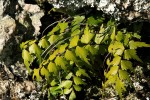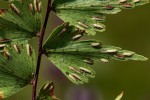Asplenium megalura
Selected images: Click on each image to see a larger version and details of the record View all images (7)
Photo: Petra Ballings
Along main road between Lake Kaulime turn-off and Kaperepeze road, Nyika National Park
Detailed records: Display species records QDS maps by: Google Maps Point records by Google Maps
Species details: Click on each item to see an explanation of that item (Note: opens a new window)
| Synonyms: |
Asplenium dimidiatum Sw. var. longicaudatum Hieron. Asplenium megalura Hieron. ex Brause var. molleri (Hieron.) Tardieu Asplenium megalura Hieron. ex Brause var. exhaustoides G. Kunkel Asplenium molleri Hieron. |
| Common names: | |
| Frequency: | |
| Status: | Native |
| Description: |
Rhizome erect or shortly creeping, to 5 mm diameter; rhizome scales dark brown, narrowly lanceolate, entire, up to 6 mm long with narrow pale brown borders, apex gradually tapering to a point and ending in hair-tip. Fronds tufted, rarely shortly spaced, arching, firmly membranous, not proliferous. Stipe shiny dark brown or greyish, up to 19 cm, glabrous except at the very base. Lamina up to 43 × 13 cm, 1-pinnate, narrowly oblong in outline, lowest pinnae not reduced, apical segment resembling others, often tricuspidate. Pinnae (sub-)opposite, subsessile, trapeziform in outline, 3-lobed, up to 9 × 4 cm, up to 11 pairs, base wedge-shaped, lower margin entire, apex abruptly ending in a very long tip, the distal margin and tip irregularly toothed, glabrous on both surfaces or with some scattered tiny lobed scales to 0.5 mm, veins flabellate, costa not clear. Rhachis shiny dark brown, shallowly channelled ventrally, glabrous except for a few very small scales. Sori many per pinna, along veins, linear, (3–)5–20 mm long; indusium linear, membranous, entire, 0.4–0.5 mm wide. |
| Type location: |
|
| Notes: |
Differs from similar species by having pinnae with an apex that abruptly ends in a very long tip, this species is not proliferous. Although most literature only gives evergreen forests as preferred habitat we have found it also commonly on more exposed rocky outcrops in montane grassland, particularly on the Nyika Plateau in Malawi. |
| Derivation of specific name: | |
| Habitat: | Lithophyte or epiphyte in wet evergreen forests and on rocky outcrops in montane grassland. |
| Altitude range: (metres) | 1370 - 1980 m |
| Worldwide distribution: | Widespread in tropical Africa |
| FZ divisions: | N,Z |
| Growth form(s): | Epiphyte. |
| Endemic status: | |
| Red data list status: | |
| Insects associated with this species: | |
| Spot characters: | Display spot characters for this species |
| Images last updated: | Saturday 4 May 2019 |
| Literature: |
Beentje, H.J. (2008). Aspleniaceae Flora of Tropical East Africa Pages 24 - 26. (Includes a picture). Burrows, J.E. & Burrows, S.M. (1993). An annotated check-list of the pteridophytes of Malawi Kirkia 14(1) Page 93. Burrows, J.E. & Willis, C.K. (eds) (2005). Plants of the Nyika Plateau Southern African Botanical Diversity Network Report No. 31 SABONET, Pretoria Page 25. Da Silva, M.C., Izidine, S. & Amude, A.B. (2004). A preliminary checklist of the vascular plants of Mozambique. Southern African Botanical Diversity Network Report No. 30 Sabonet, Pretoria Page 9. Dowsett-Lemaire, F. (1989). The flora and phytogeography of the evergreen forests of Malawi. I: Afromontane and mid-altitude forests; Bull. Jard. Bot. Nat. Belg. 59(1/2) Page 26. Fischer E. & Lobin W. (2024). Checklist of Lycopodiopsida (clubmosses and quillworts) and Polypodiopsida (ferns) of Rwanda. Willdenowia 53(3) Page 158. Fischer, E. & Lobin, W. (2023). Synoptic Revision of Aspleniaceae (Asplenium, Hymenasplenium) of Rwanda. Phytotaxa 608 (1) Pages 29 - 30. Kornas, J. (1979). Distribution and ecology of the Pteridophytes in Zambia Polska Akademia Nauk Wydzial II Nauk Biologicznych Page 101. Ntore, S. & al. (2024). Checklist of the vascular plants of Burundi Page 29. Roux, J.P. (2001). Conspectus of Southern African Pteridophyta. Southern African Botanical Diversity Network Report 13 Page 168. Roux, J.P. (2009). Synopsis of the Lycopodiophyta and Pteridophyta of Africa, Madagascar and neighbouring islands Pages 90 - 91. Schelpe, E.A.C.L.E. (1970). Pteridophyta Flora Zambesiaca Pages 180 - 181. |
Other sources of information about Asplenium megalura:
Our websites:
Flora of Burundi: Asplenium megaluraFlora of Malawi: Asplenium megalura
Flora of Rwanda: Asplenium megalura
Flora of Zambia: Asplenium megalura
External websites:
African Plants: A Photo Guide (Senckenberg): Asplenium megaluraAfrican Plant Database: Asplenium megalura
BHL (Biodiversity Heritage Library): Asplenium megalura
EOL (Encyclopedia of Life): Asplenium megalura
GBIF (Global Biodiversity Information Facility): Asplenium megalura
Google: Web - Images - Scholar
iNaturalist: Asplenium megalura
IPNI (International Plant Names Index): Asplenium megalura
JSTOR Plant Science: Asplenium megalura
Mansfeld World Database of Agricultural and Horticultural Crops: Asplenium megalura
Plants of the World Online: Asplenium megalura
Tropicos: Asplenium megalura
Wikipedia: Asplenium megalura






